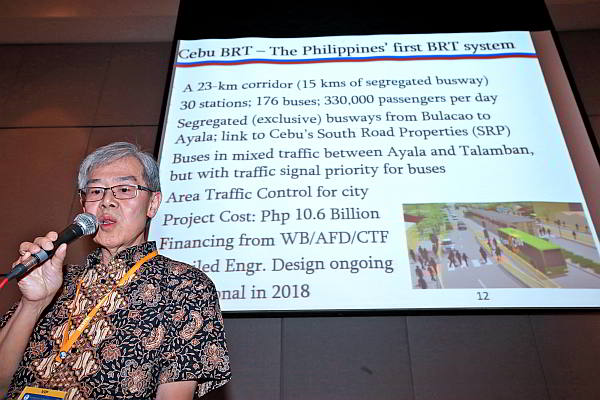‘BRT should be top choice of transportation’

Robert Y. Siy, senior adviser of the Office of the Undersecretary for Planning of the Department of Transportation and Communication (DOTC) presents a PowerPoint analysis of the Bus Rapid Transit (BRT) project in Metro Cebu. (CDN Photo/Junjie Mendoza)
The implementation of the Bus Rapid Transit (BRT) system in Cebu City is critical not only in reducing traffic congestion but in reshaping the government’s goal to build a reliable mass transport system.
Robert Siy, a senior adviser to the undersecretary of the Department of Transportation and Communication (DOTC), said public transport like the BRT should be the top choice of every Filipino for their daily commute, even when they have cars or motorcycles.
“That should be the goal. In fact, that is the goal in many of the top cities in the world,” he said in yesterday’s special session on Philippine Metro Transport Systems during the 11th Eastern Asia Society for Transportation Studies (EASTS) Conference.
Siy said several cities in South Korea, for example, have car-free zones for a certain period of time since 2011.
Transportation in South Korea is provided by extensive networks of railways, highways, bus routes, ferry services and air routes across the country.
High quality
A BRT system is already present in Bogota, Columbia, transporting 40,000 people an hour; Guangzhou, China, with 30,000 passengers an hour; and one proposed in Rio de Janeiro, Brazil, which can serve 60,000 passengers an hour.
Unless an efficient mass transport system is in place, Siy said the traffic situation in cities like Cebu and Manila will only get worse.
Last week, Metro Manila witnessed the biggest traffic deadlock of the year due to flash floods.
Siy said public transport should be elevated from low quality-high emission to high quality-low emission.
“We need to go for public transport that’s sufficient, high quality, reliable, affordable and safe,” he said.
Study
The special session, which lasted for an hour and 30 minutes, was also the venue of presentations like the Metro Cebu Infrastructure road map, presented by Ramon Aboitiz Foundation Inc. (RAFI) Executive Director Evelyn Nacario-Castro.
This road-map study includes a sub-roadmap for a highway network and public transport for Metro Cebu detailing projects like a feasibility study on potential mass transit systems and the Cebu City BRT project.
Also included in the road map is the Carcar Public Transport Terminal and the P16-billion dual-mode bridge connecting Mactan Island and mainland Cebu, among others.
Siy was tasked to present the proposed BRT system in Cebu and Metro Manila to delegates from different parts of East Asia.
The Cebu BRT System will be the first ever in the Philippines. It covers 23 kilometers with 16km. of segregated bus way.
Big challenge
It will be composed of 30 stations, 176 buses is and expected to carry 330,000 passengers daily.
The route spans from Bulacao to Ayala Mall along Cebu South Road, N. Bacalsco Ave., Osmeña Boulevard and N. Escario Street, and further 6km. of bus priority at junctions will allow BRT buses to reach Talamban by way of Gov. M. J. Cuenco Avenue.
Funding will be sourced from the World Bank, the Agence Française de Developpement (AFD), and the Clean Technology Fund (CTF) Philippines, with a projected cost of P10.6 billion for the first phase.
Siy said a detailed engineering plan is still being crafted and the DOTC expects the project to be operational by 2018.
“Getting there is not easy. It really needs the involvement of the public sector and the transport industry,” he said.
Transitioning from the present public transport system to the proposed “transformed” version is going to be a big challenge, Siy said.
But he said it will generate more jobs and improve traffic conditions.
Disclaimer: The comments uploaded on this site do not necessarily represent or reflect the views of management and owner of Cebudailynews. We reserve the right to exclude comments that we deem to be inconsistent with our editorial standards.
